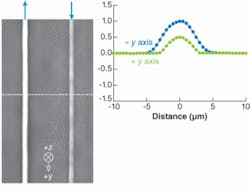MATERIALS SCIENCE: Ultrafast laser reveals nonreciprocal photosensitivity
Researchers at the Optoelectronics Research Centre (ORC) at the University of Southampton (England) and the University of Joensuu (Finland) have presented what they claim is the first evidence of nonreciprocal photosensitivity.1 This is an effect that could have a significant impact on optical data storage, laser machining, and surgery.
Photosensitivity is a material property that is relevant to many phenomena and applications, from photosynthesis and photography to ultrafast laser writing. Conventional wisdom has it that in a homogeneous medium, properties like photosensitivity do not change when the direction of light propagation is reversed. The new work, however, demonstrates that reversing the direction of a laser beam in a lithium niobate (LiNbO3) crystal causes the structures written in that crystal to be mirrored rather than remain the same when measured in opposite directions on an axis orthogonal to the beam.
The experiments were performed at the ORC using a modelocked, regeneratively amplified Ti:sapphire laser, producing 150 fs pulses at 800 nm with a 250 kHz pulse repetition rate. The linearly polarized laser beam was focused to a spot size of 2 µm, 150 µm below the surface of a 1-mm-thick LiNbO3 sample. Lines were written into the sample by moving the crystal across the beam; along these lines the refractive index was changed by the high-energy pulses of the beam. The exact nature of the change depended on the pulse energy, which was in the range of microjoules. The group was surprised to observe that as the pulse energy increased, a directionality emerged. If the laser beam axis is the z axis, then the refractive index change depended on whether the crystal was translated in the y or the -y direction. There was a mirror change in the structural modifications when the propagation direction of the writing beam was reversed, from z to -z. Further experiments with picosecond laser sources revealed no nonreciprocal effects with these longer pulses. The team believes this is because higher intensities can be achieved with femtosecond pulses with minimal sample damage.
Directional dependence
Previously, researchers noticed a directional symmetry in glass because of a tilted intensity front of a pulse. This is something like a snowplow effect. In contrast to glass, however, the directional dependence of writing in LiNbO3 seems to depend on the anisotropy of the crystal itself and does not require a tilted pulse. Instead the effect depends on the orientation of the crystal with respect to the direction of the beam movement and the direction of light propagation. The written structures have a strong anisotropy only when the focused beam is translated along the y axis, not along the x axis.
The team has postulated an explanation for this effect. The intense laser pulse produces a short-lived plasma. The crystal anisotropy means that the current from this plasma flows anisotropically. This in turn produces a heat anisotropy that the following pulse encounters. Because the heating of the crystal is stronger when the direction of the heat flow coincides with the direction of the beam movement there is a pronounced directional dependence.
“Our results challenge a common belief that the photosensitivity of a homogeneous medium, or the amount to which such a medium reacts upon light irradiation, does not change on reversing the direction of light propagation,” said Peter Kazansky, a professor at the ORC. “This property is related to many phenomena and applications, from photosynthesis to laser machining. On the other hand, noncentrosymmetric media, such as piezoelectric, ferroelectric, and chiral materials, to mention only few, also have many applications in optics, electronics, and biology. Nonreciprocal photosensitivity adds a new parameter—light propagation direction—that could be used to control interaction of light with these materials.”
While the team’s current demonstration is related to ultrafast laser writing, it is looking for applications of the phenomenon for data storage, optical manipulation, trapping and laser surgery.
REFERENCE
1. W. Yang, P.G. Kazansky, and Y.P. Svirko, Nature Photonics 2, 99 (2007); doi:10.1038/nphoton.2007.276
About the Author

Gail Overton
Senior Editor (2004-2020)
Gail has more than 30 years of engineering, marketing, product management, and editorial experience in the photonics and optical communications industry. Before joining the staff at Laser Focus World in 2004, she held many product management and product marketing roles in the fiber-optics industry, most notably at Hughes (El Segundo, CA), GTE Labs (Waltham, MA), Corning (Corning, NY), Photon Kinetics (Beaverton, OR), and Newport Corporation (Irvine, CA). During her marketing career, Gail published articles in WDM Solutions and Sensors magazine and traveled internationally to conduct product and sales training. Gail received her BS degree in physics, with an emphasis in optics, from San Diego State University in San Diego, CA in May 1986.
